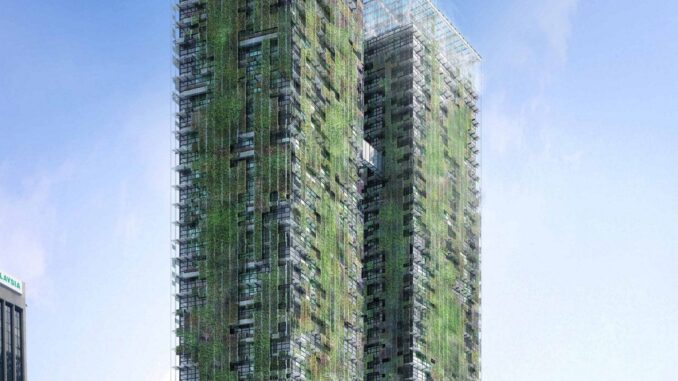
By Dr.Abhijit Sarkar, Country Head-Corporate Real Estate, Administration, Infrastructure & Sourcing- Sharekhan Ltd.

As a member of the Royal Institution of Chartered Surveyors London, (MRICS), Dr. Abhijit is responsible for the corporate real estate, administration, general services, facilities (soft and technical services), infrastructure, purchase and sourcing, health and safety, security, travel, and MICE, etc, have been instrumental in writing handbooks, manuals process notes for most of the organizations. Dr.Abhijit is presently the Vice President & Country Head-Corporate Real Estate, Administration & Infrastructure for ShareKhan Ltd.
In a world exhausting our natural resources, green building has become the ethical “in-thing” in an attempt to save our planet from despair. This, however, can only be achieved through a concerted effort by architects, engineers and construction companies and of course, the support of the concerned citizen. And that’s where, there is a great need of “Green Buildings, whereby ensuring sustainable tomorrow.
What is Green Building?
A green building is one that is both intelligent and green. It is a building that uses both technology and process to create a facility that is safe, healthy and comfortable, and enables productivity and well being for its occupants. It provides timely, integrated system information for its Owners and investors, so that they may make intelligent decisions regarding its operation and maintenance, and has an implicit logic that effectively evolves with changing user requirements and technology, ensuring continued and improved intelligent operation, maintenance and optimization. A green building is designed, constructed, and operated with minimum impact on the environment, with emphasis on conserving resources, using energy efficiently and creating healthy occupied environments. It meets the needs of the present without compromising the needs of future generations.

In green buildings, fully networked systems transcend the simple integration of independent systems to achieve interaction across all systems, allowing them to work collectively, optimizing a building’s performance, and constantly creating an environment that is conducive to the occupants goals. Additionally, fully interoperable systems in these buildings tend to perform better, cost less to maintain, and leave a smaller environmental imprint than individual utilities and communication systems
Green buildings provide a dynamic environment that responds to occupants’ changing needs and lifestyles. As technology advances, and as information and communication expectations become more sophisticated, networking solutions both converge andautomate divergent technologies to improve responsiveness, efficiency, and performance. To achieve this, bright green buildings converge data, voice, and video with security, HVAC, lighting, and other electronic controls on a single network platform that facilitates user management, space utilization, energy conservation, comfort, and systems improvement.
There are numerous benefits that green building holds, some of them include the following:
Savings on Energy Costs:
Green buildings earn substantial benefits compared to non-green buildings, in particular greater energy efficiency compared to standard buildings and significant lower operations costs. Energy costs represent approximately 30% of an office building’s total operating costs (excluding staffing costs), hence, providing enormous opportunity for building owners not only to reduce operating costs but also to make significant improvements in the overall environmental performance of buildings.
Savings on Operating Cost:
Ongoing operating costs represent almost 50% of a building’s total life cycle costs over an estimated 40- year life span. Therefore, even a modest reduction in lifetime operating costs can enhance a building’s asset value. Owners responsible for energy utility payments in gross lease systems are driven further to maintain or lower energy operating costs and increase asset value upon building sale. Controlling operating expense increases affects more than cash flow. Since building net operating income decreases when operating costs rise, increasing costs lower the building’s asset value. Energy Star notes that where an owner invests in upgraded energy systems and technologies, these incurred costs can achieve a 20-30% ROI, with minimal risk.
Water Conservation:

The acceleration of climate change has created a sense of urgency for water managers to prepare for both increased drought conditions, as well as the increased severity of flooding. Coupled with the increasing unpredictability of rainfall, increasing consumption volumes in the commercial and industrial sectors are making water management an urgent issue in many areas. To help address these budget issues, and other incentives for facilitating water conservation and storm water management are on the rise.
Comfort and Productivity:
The non-energy benefits of commissioning of both new construction and existing buildings have a major impact on building performance and occupant comfort. Since occupant costs command the greater proportion of building life cycle costs in owner-occupied buildings enhancing occupant productivity in high-performance buildings, often measured through reduced absenteeism, can result in major operational savings. Due to the relative size of staffing expenses as compared to other operating expenses, building owners can leverage effective energy management retrofits to produce significant administrative savings.
The industry is expected to experience rapid growth for projects advocating intelligent-to-green building solutions; however, the deployment and success of the solution will ultimately rest on the capability and experience of the project team and the return on any additional investment required. Ultimately, the implementation of intelligent technologies will cost less than traditional technologies, because lifetime operating costs are significantly lower and labor costs are also likely to drop significantly. This concept of intelligent, green and profitable, is what we call a green building.





Be the first to comment